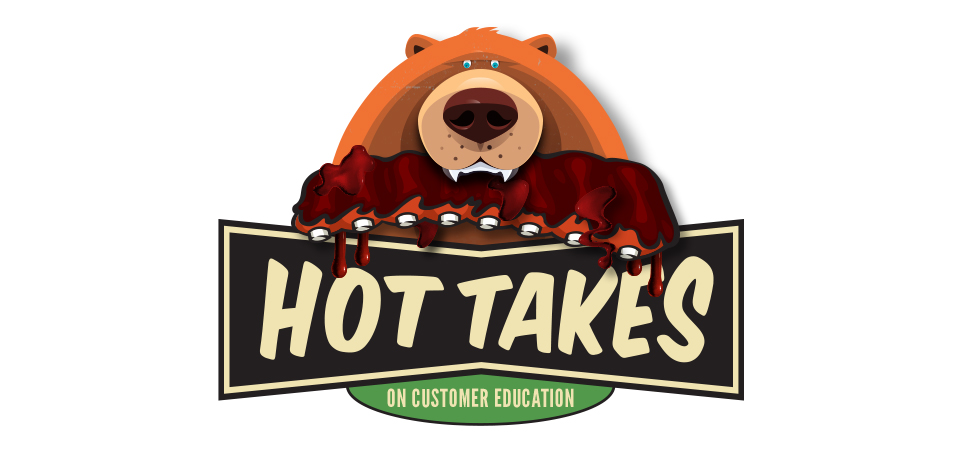After my recent appearance on Ryan Dillon’s Hot Takes, the series where we share hot and spicy opinions on the learning industry, I wanted to revisit some of my own hot takes on customer education, and share some additional context from my experience on the topics we discussed.
Here’s your recap, covering how to build mutual accountability across departments, and some top tips on fueling the journey from customer to advocate.
Hot Take #1: Getting Deep is More Important than Adding Users
- You need more learners and more depth to be successful
- If I had to choose, I’d go for depth, helping users to uncover greater value
- When users see value, they come back again and again
- Regular usage spreads the word about your product — as no-one works in a silo
Ryan asked me whether it’s more important to reach a greater number of learners, or increase my depth with a handful of existing users. I love that question! The truth is, you really need both in order to be successful.
If I had to lean in a direction though, I would definitely choose more depth of users. I’m always thinking about how to help users to find top tips and best practices that help them to do their job better. We want to eliminate the light, point-and-click style of software experiences, and help customers to get better at doing their job, using your technology.
The truth is, more depth helps to get more users, too. Providing a level of depth is going to make it more likely that users will come back for more, increasing their usage of the product and using it on a weekly or even daily basis. Once users start using your product, they can’t do it alone. People don’t work in a silo, so they will share and engage with your product across departments, and that’s how you can start to grow the number of users, too.
When education reduces friction and accelerates time to value, customers can quickly become evangelists. Your product is likely to be intuitive to start with, but education can act like the oil that reduces the friction of learning, and shows the user the best way to use your product.
Education is so critical to building engagement because identifying best practice takes time and experience, but users need to be successful right now, straight out the gate. Education bridges that gap and drives engagement because then users feel like they are becoming good at something useful, not just learning the ins and outs of a new tool but really learning a new skill.
Hot Take #2: Being in Demand is Where Good Stuff Happens
- It’s not a bad thing to be struggling to keep up with demand
- Revenue generation can help you get buy-in for more trainers for paid education
- Digging into the data will be important when showing the value of free training
- Go with evidence to the C-suite, as Customer Education is held to a high standard
What happens when a team can’t keep up with demand?
To better translate demand into actionable data for your executive team, look at the revenue generation from paid-for training, explaining that you don’t have enough people to meet demand, so you’re losing out on direct sales. At Lucid, our leaders do understand that training itself is beneficial, but that’s not always the case, so you may need to get a bit deeper to show the value of non-paid education.
I like to look at how users are interacting with the training materials in aggregate. We recently had a use case where one team looked at what occurred when users took 4 specific courses. They found that users who took all four courses were 27% more active in the product in the weeks after than the weeks before, which was a really powerful metric to be able to share to get buy-in for additional training.
Once you see the trend in the data, communicate directly and succinctly to leadership about what they find valuable. This could be product adoption or engagement, conversion rate, CSAT and NPS, or simply bottom line dollars. I’ve found that Customer Education is often held to a higher standard than the rest of the business. When we find that training has caused a spike in retention or engagement, people yell “Well, maybe those users were just more likely to engage anyway, because their personality is that they like to get involved!”. That’s why you need to partner closely with analytics to make sure you have clear measurements that can’t be discounted.
Hot Take #3: Mutual Accountability is Where You See Results
- Aligning your objectives with other departments can help to drive success in customer education
- People may be worried about CE stepping on their territory
- Mutual accountability means you have shared goals, and are judged by shared results
Aligning with other teams is also really important. We make our teams mutually accountable for the success of a project, which can reduce the friction of getting support. We can go to a team and say, “Hey, you’re being beat over the head with this particular goal, so let’s do this together and we can have a lot more success.” As Ryan said, Marketing and Product are both ultimately tasked with educating the customer, too!
Truthfully, Marketing and Product have all the control over getting content to customers, so it’s critical to have their support. I’ve been trying to drive more users to training for years, but my team owns none of the distribution channels! We need to work hard to convince other teams to use our content, clawing and scraping for every user. However, when these teams are tasked with driving traffic to learning resources, suddenly you both have the same goal. They own a number that’s within their control, and you own the resources and content. Now you have to work together to be successful.
Hot Take #4: Never, Ever Do Your Own LMS Implementation
- The expertise of a third-party vendor is invaluable when implementing technology
- This is true whether you’re working with a patchwork of home-grown tech, or starting from scratch
- Without a tight change management plan, both you and your customer can fail
Finally, the conversation turned to implementation of new technologies. Maybe it was the hot sauce in my burrito — but I got very heated! I strongly believe that no-one should be doing their own implementation.
The expertise that comes from a third-party LMS vendor who has done this over and over again is invaluable. Whether you’re trying to patch together something home-grown, or starting from scratch — you want that knowledge in place. You want someone who’ll show you which stakeholders should be available, what the impact is, and what other companies have benefited from.
Ultimately, the risk of approaching your own implementation is that you’ll fail or your customer will fail. Even with the simplest, easiest tools, there’s going to be a learning curve. There will be cognitive load, and what we call “blank canvas syndrome,” which is not knowing what you don’t know. And the customer will always prioritize their own needs over yours.
Without a tight change management plan, and a plan for configuration, enablement and long-term adoption, both you and your customer are likely to fail.
Bear Shelton is the Senior Manager of Customer Education at Lucid Software, where he has been for over five years. Previously, he spent time as an independent consultant, and was also a technical trainer at Northwestern Mutual.




